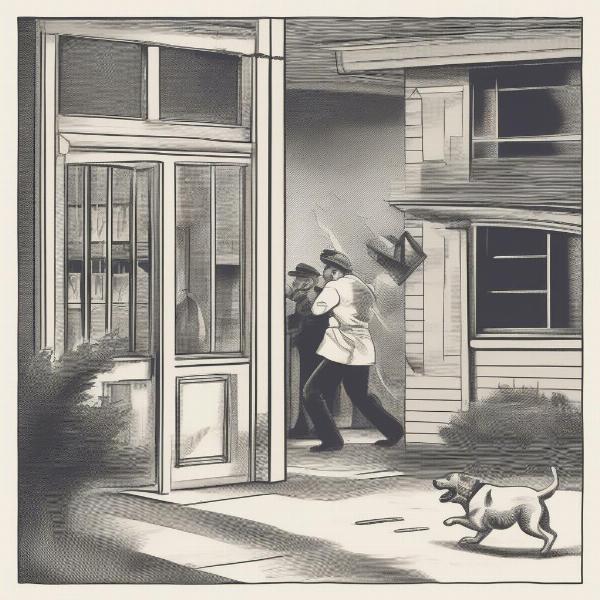Finding the right bark collar can be a game-changer for dog owners dealing with excessive barking. But with so many options on the market, choosing the top rated dog bark collar for your furry friend can feel overwhelming. This guide will help you navigate the world of bark collars, exploring different types, features, and training tips to ensure a positive experience for both you and your dog.
Understanding Dog Bark Collars
Bark collars are designed to interrupt and discourage excessive barking. They work through various methods, including vibration, ultrasonic sound, and citronella spray. It’s crucial to understand these different types to choose the most suitable option for your dog’s temperament and barking habits. Some collars use static correction, but these are controversial and should only be considered as a last resort after consulting with a certified professional dog trainer.
Types of Bark Collars
Citronella Spray Collars
These collars release a harmless burst of citronella spray near the dog’s nose when they bark. The scent disrupts the barking and redirects their attention. Citronella spray collars are often a good starting point for dogs who are sensitive to other forms of correction.
Ultrasonic Bark Collars
Emitting a high-pitched sound that only dogs can hear, ultrasonic collars deter barking by creating a mildly unpleasant sensation. These collars are a humane alternative to static correction, but their effectiveness can vary depending on the dog’s sensitivity to the sound.
Vibration Bark Collars
These collars deliver a gentle vibration when the dog barks. The vibration acts as a distraction and interrupts the barking behavior. Vibration collars are a good option for dogs who respond well to tactile feedback.
Choosing the Right Bark Collar: Key Considerations
Several factors play a crucial role in selecting the most effective bark collar. Consider your dog’s size, breed, temperament, and the severity of their barking problem. Consulting with a veterinarian or certified professional dog trainer can help you make an informed decision.
Size and Fit
Ensure the collar fits snugly but comfortably, allowing for two fingers to fit between the collar and your dog’s neck. A proper fit is essential for both safety and effectiveness.
Bark Sensitivity Levels
Many collars offer adjustable bark sensitivity levels. Start with the lowest setting and gradually increase it if needed. This ensures the collar only activates when your dog barks excessively.
Battery Life and Charging
Consider the battery life and charging options of the collar. Some collars are rechargeable, while others require battery replacements.
 Dog Barking at Mailman
Dog Barking at Mailman
Training Tips for Effective Bark Collar Use
Using a bark collar effectively requires consistent training and positive reinforcement. Never rely solely on the collar to solve barking issues. Address the underlying causes of the barking, such as boredom, anxiety, or territoriality. Combine the collar with obedience training and other behavior modification techniques for optimal results.
Conclusion
Choosing the top rated dog bark collar involves careful consideration of your dog’s individual needs and the various collar types available. By understanding how these collars work, and by implementing proper training techniques, you can effectively address excessive barking and create a more peaceful environment for both you and your furry companion. Remember, a bark collar is just one tool in your training arsenal. A holistic approach that addresses the root cause of the barking is crucial for long-term success.
FAQ
- Are bark collars cruel? When used responsibly and humanely, bark collars can be an effective training tool. Avoid static shock collars and prioritize positive reinforcement methods.
- How long can I leave a bark collar on my dog? It’s generally recommended not to leave a bark collar on for more than 12 hours at a time.
- Will a bark collar stop my dog from barking altogether? Bark collars are designed to reduce excessive barking, not eliminate it entirely.
- Can I use a bark collar on a puppy? It’s generally not recommended to use bark collars on puppies younger than six months old.
- What if my dog’s barking gets worse with the collar? If your dog’s barking worsens, consult with a veterinarian or certified professional dog trainer.
- Are there any alternatives to bark collars? Yes, alternatives include training, behavior modification, and addressing underlying anxiety or boredom.
- How do I choose the right bark sensitivity level? Start with the lowest setting and gradually increase until the collar activates only with excessive barking.
Related Articles
- ultrasonic deterrent for dogs
- electric dog collar nz
- barking dog bakery & boutique
- dog friendly restaurants in pasadena
ILM Dog is a leading international dog website, providing expert advice and valuable resources for dog owners worldwide. We cover everything from breed selection and healthcare to training, nutrition, and grooming. Our focus is on promoting responsible dog ownership and enhancing the bond between humans and their canine companions. For expert guidance on dog care and training, or to explore our wide range of products and accessories, contact us at [email protected] or call us at +44 20-3965-8624. Visit ILM Dog today for all your dog-related needs.